 |
|

|
 |
TABLE of CONTENTS
 |
Commissioner Sorel talks virtually to employees |
By Donna Lindberg

Commissioner Tom Sorel spoke to Mn/DOT employees via live video stream on Dec. 17. This was the first time that the commissioner used this technology to communicate with employees. Photo by David Gonzalez |
Commissioner Tom Sorel spoke to Mn/DOT employees via live video stream on Dec. 17. This was the first time that the commissioner used this technology to communicate with employees.
“I’d like to use more of these and other kinds of communications techniques in the future to communicate with you and get your feedback,” he said. “In the future, I’d like to hold innovation jams online where employees can respond to ideas.”
Sorel began with a discussion of the state budget situation, noting that Mn/DOT is in a better position than many other agencies and departments of transportation. Jon Chiglo, recently project manager for the Interstate 35W bridge re-build, has been named project manager for overseeing Chapter 152 funding from the 2008 Legislature. He is working with internal staff and the contracting industry to get projects out the door. He also will work with Mn/DOT’s federal partners to eliminate some barriers.
Looking to future, the commissioner indicated that Mn/DOT will be okay in 2009. There will be a small deficit that can be addressed internally, but he doesn’t anticipate any layoffs in the short term. The situation in 2010 and 2011 will be monitored and communicated to employees as it unfolds, he said.
The commissioner said that themes of the Dec. 15-16 managers’ conference were trust, collaboration, partnering and transformational leadership. Participants also discussed the department’s strategic vision and how we can improve as a department.
“I had asked Seeds students to come up with a strategic vision for the department from their perspective as representatives of our future, as people coming up in the transportation community,” Sorel said.
Emma Corrie, recruitment programs manager, Office of Human Resources, Denise Hals, Seeds program manager, and former and current Seeds students Rebecca Fabunmi, engineer in Metro Design; Sulmaan Khan, engineer, Metro Right of Way; Arnoldo Martinez, research analyst, Office of Investment Management, and Belick Pha, Seeds student, Office of Human Resources, presented the vision. Others involved in development of the vision were Kim Collins, affirmative action officer, and Seeds student workers Jessica Etukudo, Natashia Lambert-Knapp and Robert Plagge.
The vision focuses on leadership and collaboration and puts safety at the top of the list of core values that also include valuing diversity and committing to employee well-being. The vision is a call to all Mn/DOT employees to be ambassadors for Mn/DOT. When it is completed, it will be posted on iHUB and shared with the department’s external partners.
“These folks did a tremendous job of seeking input from various parts of the department. I’m very proud of everybody who worked on this,” Sorel said.
In closing, Sorel talked about the importance of safety. Mn/DOT is working hard with its partners on the Toward Zero Deaths effort that has set a goal of fewer than 400 fatalities a year by 2010. To date, Minnesota has had 60 fewer fatalities than last year. Seatbelt usage in the state is 87 percent, remarkable for a state without a primary seat belt law, he said.
“While no death is acceptable, this is good news,” Sorel said.
The commissioner also reported that the FIRST driver who was injured in a crash in the Twin Cities on Tuesday is fine. Three snowplow trucks were hit in the Metro District during the last couple of days, but nobody was hurt in those crashes.
“We’ve had an early winter. I’ve been getting many positive messages, including from Congressman Oberstar’s staff, praising us for our efforts,” Sorel said. “I want to thank you all for your work that often goes unrecognized.”
If you were not able to view the live broadcast Dec. 17, a recording of the message will be available on Thursday, Dec. 18, by clicking on this link: mms://stream2.video.state.mn.us/DOT/commissioner-121708.wmv. If the link doesn't open Windows Media Player, cut and paste it into Internet Explorer.
|
 |
|

|
 |
TABLE of CONTENTS
 |
Fierce storm hampers statewide travel during Dec. 13-14 weekend |
By Craig Wilkins
Like an ice-coated battering ram, a fierce winter storm smashed through Minnesota Dec. 13-14 with snow, winds and dangerous cold that forced some highway closings in its wake.
The storm’s most severe effects skirted southern Minnesota and the Twin Cities metropolitan area, reserving their full force for southwestern, northwestern and northern Minnesota.
Long sections of highways were closed on Dec. 14, including Interstate 94 from Moorhead to Fergus Falls, Hwy 10 from Moorhead to Detroit Lakes, and Hwy 210 between Breckenridge and Fergus Falls in District 4.
Dana Hanson, district public affairs coordinator, said District 4 pulled its plows off the roads for several hours due to poor visibility.
Temperatures dipping to 30 degrees below zero complicated travel and snowplowing operations in District 1. John Bray, special assistant to the district engineer, urged that motorists avoid unnecessary travel, as did many district spokespeople throughout the storm.
Diane Beck, public affairs coordinator for District 8, warned against travel Dec. 14 due to slippery road conditions, high winds and limited visibility, which was limited to 100 feet in some areas. Rain earlier in the day made traveling even more treacherous, she said.
Todd Haglin, Mn/DOT’s safety director, said the only storm-related crash involving agency employees occurred early Dec. 16 in the Twin Cities when a vehicle struck a FIRST truck that had stopped at the scene of a rollover crashing near the I-35/I-494 interchange in Richfield.
Adam Breheim had just taken a person involved in the crash into his truck when it was hit from behind. Neither Breheim nor the other person was injured.
The crash was reported widely by the news media. News reports stressed driving safety and the need to observe the state’s “Move Over” law, which requires drivers to move a lane over, when possible, to provide a wider margin of for safety for law enforcement officers, highway maintenance crews and other emergency responders.
|
 |
|

|
 |
TABLE of CONTENTS
 |
A troublesome morning unfolds Dec.17 in District 6 |
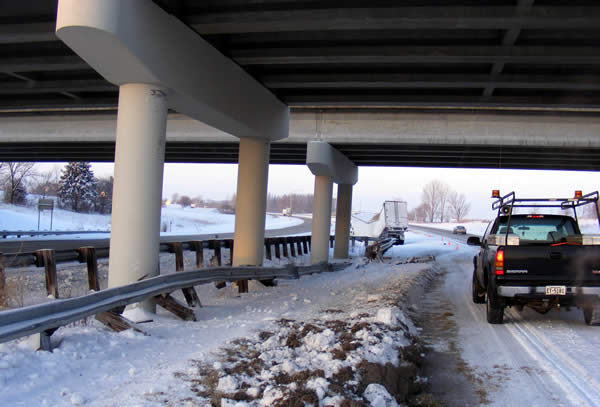
Incidents ranging from a fatal crash near Albert Lea to a train derailment near Dresbach and a semitrailer hitting a bridge pier south of Winona Dec. 17 caused traffic delays at three locations in the Rochester District.
The fatality resulted from a multi-vehicle crash on Interstate 35. Northbound traffic was detoured; the freeway opened fully to traffic in the afternoon.
Two freight trains collided, blocking the westbound exit ramp from I-90 to Dresbach. The crash also involved chemical leaks. Two people were injured. Traffic was detoured to another exit for several hours.
The morning also included a crash (shown above) when a truck hit a bridge pier at the I-90/Hwy 43 interchange. Traffic was restricted until a bridge inspection determined there was no critical damage to the pier. No injuries were reported.
Kristine Hernandez, public affairs coordinator, said district crews responded quickly to manage traffic and restore operations on the affected roadways. Photo by Larry Waletzki
|
|
 |
|

|
 |
TABLE of CONTENTS
 |
Last of bond-accelerated projects completed; provided significant safety, mobility improvements statewide |
By Donna Lindberg
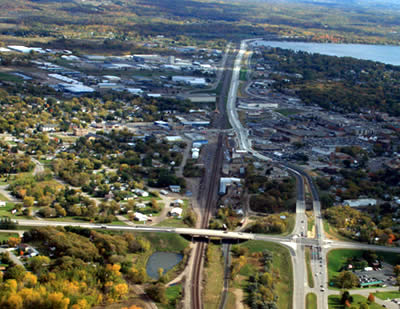
Reconstructing Hwy 10 through Detroit Lakes was one of the last projects to be completed under the $900 million transportation funding package the Pawlenty-Molnau administration secured in 2003. Photo by Dana Hanson |
A project to widen Hwy 34 through Park Rapids and another to reconstruct Hwy 10 through Detroit Lakes were the last projects to be completed with more than $900 million Pawlenty-Molnau Transportation Finance Package funds approved by the Minnesota Legislature in 2003.
Through this funding, Mn/DOT was able to accelerate 19 major highway capital improvement, safety and preservation projects statewide 65-plus years ahead of schedule.
The legislation authorized the sale of $400 million in highway bonds. Revenue from the bonds allowed the state to access $425 million in advance federal funds for 2004-07.
In addition to bond accelerated funds, the package also included:
- Up to $100 million over four years to advance rehabilitation projects to improve safety and help preserve existing roadways
- $36 million for statewide transit capital improvements, including park and ride lots, bus ramps and buses
- $5 million in federal funds for public transit systems in Greater Minnesota
Accelerating projects saved approximately $140 million in construction inflation costs and generated an additional $200-$300 million in user benefits.
Large-scale projects advanced included:
- Hwy 53 in Duluth – $14.3 million project completed in 2007 to reconstruct the Trinity Road portion of this roadway from two to four lanes and add center turn lanes improved mobility and increased safety for travelers, residents and truckers on this important connection to and from the Twin Ports, Duluth Airport and northern Minnesota.
- Hwy 34 through Park Rapids – This $12.9 million project to widen Hwy 34 to five lanes was the last 2003 funded project to be completed in late October. It is expected to increase capacity and alleviate congestion. Improving access, adding a continuous two-way left turn lane and realigning intersections will improve mobility and safety.
- Hwy 371 north of Little Falls – This $20.5 million four-lane reconstruction project, completed in 2005, improved mobility on one of the fastest growing highways in the state.
- Hwy 101 near Elk River – This $62.3 million project completed this summer to upgrade signalized intersections on Hwy 101 at Wright County Hwy 36, Hwy 37, Hwy 39 and Hwy 42 to full interchanges and reconstruct highway to freeway standards has improved safety and increased traffic flow on this busy connection between I-94 and Hwy 10.
- Hwy 10 in Detroit Lakes – This $54.6 million project, completed in late October, realigned and widened three miles of Hwy 10 through Detroit Lakes. It is improving mobility and safety by reducing access points from 70 to seven. Separating local and through traffic has eliminated two at-grade railroad crossings and added an underpass that has helped unify the downtown area.
- Hwy 52 in Oronoco – A $40.4 million project to replace two dangerous, at-grade intersections with grade-separated facilities and a frontage road system on this corridor has dramatically reduced the crash potential and improved mobility and access to the local road system. Project was completed in 2007.
- Hwy 14 in Janesville/Waseca – This $47 million project added 12 miles of four-lane roadway and has improved safety and mobility on this “at risk” interregional corridor. Without 2003 funds, the project, completed in 2006, would not have been completed until 2009.
- Hwy 212 in Chaska/Carver/Chanhassen/Eden Prairie/Dahlgren - $246.4 million construction of Hwy 212 on a new alignment is easing the commute for southwest commuters and has created a vital link to Western Minnesota and South Dakota. Design-build helped advance this project by eight years, and was completed in summer 2008.
- Interstate 694/I-35E in Vadnais Heights/Little Canada – The $128.3 million “Unweave the Weave” project reconstructed this heavily congested area to six lanes in each direction; it was completed in October 2008.
- Hwy 169 in Eden Prairie/Bloomington – This $23 million project to construct new interchanges at Pioneer Trail and Anderson Lakes Parkway completed in 2005 improved interchange operations and reduced travel times in this high-priority, interregional corridor.
- I-494 in Minnetonka/Eden Prairie/Plymouth – Since completion in 2006, this $145.7 million reconstruction from four to six lanes has increased capacity 50 percent, reduced congestion, saved travel time and maintenance costs.
|
 |
|

|
 |
TABLE of CONTENTS
 |
Bridge collapse data now available in Mn/DOT Library, on Web |
By Peter Zuniga, Data Practices office
With the conclusion last month of the National Transportation Safety Board’s investigation into the probable cause of the Interstate 35W bridge collapse, public investigatory data and public post-collapse data are now available electronically in the Mn/DOT Library and on the Web.
Throughout the NTSB’s 15-month investigation, federal rules classified these data as not public, according to Barbara Forsland, Mn/DOT’s data practices compliance and policy attorney.
“From the outset, Mn/DOT’s executive leadership took the stance that we would be 100 percent transparent about the data we had relating to the I-35W bridge and that the department would supply all public data under the Minnesota Government Data Practices Act in the most efficient manner possible,” Forsland said.
To that end, much of the department’s public data relating to bridges in general and the I-35W bridge in particular were posted on Mn/DOT’s Web site for easy retrieval by the news media, law firms, researchers and the public.
At the same time, Mn/DOT (and its consultants, vendors and independent contractors) must preserve all data related to all bridges in anticipation of future data requests for the information. This is known as a litigation hold, Forsland said.
To achieve the goal of transparency and to comply with the litigation hold, Forsland, Michele Bliss, Mn/DOT’s records manager, and Kim Roberson, information technology project manager, led a cross-functional team to identify, collect and preserve all data about the I-35W bridge in Minneapolis. More than 120 Mn/DOT employees participated in the data gathering project.
Mn/DOT employees supplied more than 50,000 e-mails, 50,000 e-files and 7,500 EDMS documents. A team of contract attorneys helped review the data to determine its public or not-public status under the MGDPA.
The presumption under the MGDPA, Forsland said, is that all government data are public unless a state statute or federal law says otherwise. Some of the more typical exceptions encountered were private data about employees, attorney-client privilege and security information.
The data can be found at http://www.dot.state.mn.us/i35wbridgedata/ and are accessible by any personal computer. The data are also available on two workstations in the Mn/DOT Library. A third workstation was recently established for downloading data. Note that because of file sizes, some data are only available in the library (e.g., Wiss Janney Elstner investigative data, GIS 3D Model, URS data, LIDAR data and high-resolution photos). The library requests that people reserve a timeslot to view or download the data from its workstations.
Litigation hold on all bridge data still in effect
“We are still under an ongoing obligation to preserve data related to all bridges,” said Betsy Parker, Mn/DOT’s chief counsel. “The litigation hold is in effect until further notice.”
The hold applies to Mn/DOT employees, as well as consultants, vendors and independent contractors.
Contact Barbara Forsland, 651-366-4822, or Peter Zuniga, 651-366-4837, in the Data Practices office with questions or concerns. |
|
 |
|

|
 |
TABLE of CONTENTS
 |
Public involvement efforts pay off on projects |
By Donna Lindberg
Public involvement is an important component of projects that take many years from planning through construction as well as of projects that are short-term or emergency in nature.
“Effectively involving the public in the decisions we make goes a long way toward helping Mn/DOT rebuild public trust and confidence,” said Commissioner Tom Sorel. “Public involvement is not new to Mn/DOT. We have many successes with public involvement in projects large and small and we need to learn from and build on those.”
Two recent examples of how public involvement resulted in successful outcomes include a project to realign and widen three miles of Hwy 10 through Detroit Lakes and the emergency closure of the Hwy 43 bridge in Winona this spring.
Hwy 10: listening to citizens
“Residents, businesses, local officials and the railroads that had tracks adjacent to the project were involved from the planning and design phases all the way through construction,” said Judy Jacobs, who was the District 4 public affairs coordinator throughout planning and construction. “The project gained overwhelming support that helped solve many concerns and issues and resulted in few obstacles along the way.”
Larry Buboltz, Detroit Lakes mayor, said good public involvement was vital on this project that was very important to the community.
“Mn/DOT and the contractor did an excellent job involving citizens,” Buboltz said. “They felt like they were listened to and that their opinions counted.”
Hwy 43: quick collaboration to create solutions
Involving the public in decisions on planned projects is important, but nothing creates the immediate need to involve the public like a bridge closure.
When Mn/DOT officials made the decision June 3 to close the Hwy 43 bridge over the Mississippi River between the city of Winona and Wisconsin because of corrosion in the bridge’s gusset plates, Mn/DOT and local officials had to act quickly.
“Everyone came together quickly to create solutions,” said Winona Mayor Jerry Miller.
Right after the closure, Mn/DOT, city officials, businesses, the local chamber of commerce and the Wisconsin DOT met to determine how to get people who lived on one side of the bridge across the river to jobs, school and services on the other.
“By rush hour the next Monday, we had added park-and-ride lots along the river, were busing people from some locations and were operating a ferry across the river. When I went down to the levee on Monday morning, there were positive comments about what was happening,” Miller said.
The city and local legislators also created a community bridge coalition of Minnesota and Wisconsin residents and businesses to make recommendations to Mn/DOT on bridge repairs and future reconstruction.
“It’s a neat thing for me to see that when we’ve got a problem we can work together as a community to solve it,” said Miller.
Public involvement training
Mn/DOT recently updated its public involvement training, “Hear Every Voice,” to help department planners and project staff use public involvement to achieve positive outcomes for even the most challenging projects. HEV II training courses began in October and continue into spring 2009.
“I can’t emphasize enough the importance of the HEV II training now being offered for Mn/DOT and partner employees,” Sorel said. “I believe in building strong partnerships with the public and HEV II will help us do that.”
For more information:
|
 |
|

|
 |
TABLE of CONTENTS
 |
New financial system will enhance consistency, accuracy for agency |
|
By Lisa Yang
Mn/DOT employees may not see the usual words "org," "fund," "job number" and "activity" in their timesheets if funding for a new statewide financial system is approved by the Legislature next year, according to Denise Hesselroth, Office of Financial Management.
The state is halfway through a four-year project to replace MAPS, the state’s accounting and procurement system that processes 1.3 million payments and 300,000 purchase orders annually. MAPS, which was installed in 1995, has grown increasingly incompatible with Minnesota’s other, newer systems.
In preparation for the changeover to the new statewide system, Mn/DOT is undertaking an effort called Financial Integrity Gold Standard, which will define new policies and procedures to ensure that all financial information is timely, accurate, verifiable, comparable and consistent.
Currently, Mn/DOT has 75 computer applications that hold financial data.
“Although we don’t know exactly what tool we will be moving to, by having all current systems reconcile with MAPS, the transition for the agency will be much smoother when we receive the new software,” said Hesselroth. “Our main focus is to improve financial management overall.”
In 2007, the Minnesota Department of Finance received $500,000 to continue planning the MAPS replacement project; it will ask for full funding next session. If approved, search for a vendor and a new financial software application could begin in July 2009.
Hesselroth said one concern right now is state project numbers, a formula of numbers that originally identified what work is being done on what highway but that has expanded to several other meanings.
Currently, there are many different SP numbers for one project, which makes reporting of construction project costs inconsistent.
“The new key word here is ‘bundle,’” said Hesselroth. “We are considering a system that would be used by all areas to create their SPs. The SPs could then be bundled into larger concepts such as Unweave the Weave or Crosstown. This way, we can track how much we are spending on construction projects.”
|
 |
|

|
 |
TABLE of CONTENTS
 |
PCs, laptops to use less energy |
|
Beginning this month, Mn/DOT will activate a function on all desktop computers and laptops so that monitors will turn off after 15 minutes of inactivity.
“This is one way Mn/DOT will be saving energy in compliance with the governor’s initiative requiring all state agencies to manage energy use of computers and monitors,” said Tim Leister, project manager, Office of Information and Technology Services.
Turning the monitor on again is as simple as moving or clicking the mouse, he said.
An earlier energy-saving goal—having all new state computer purchases meet the latest Energy Star ratings—went into effect in December 2007.
“Additional methods for better energy management of computers have been tested in Mn/DOT and other agencies,” Leister said. “Mn/DOT will be implementing changes in 2009 that will further support the governor’s initiative.”
Employees will receive notice before this energy-saving measure goes into effect.
For more information, contact Leister at 651-366-4057, timothy.leister@dot.state.mn.us, or visit these Web sites:
|
 |
|

|
 |
TABLE of CONTENTS
 |
Employee contributions to Combined Charities Drive top $1 million mark |
By Craig Wilkins
We are pleased with reaching our goal, especially with the severe downturn in the economy. It shows that we are in tune with the economic times and reflects good work by each agency’s campaign representatives.
Ron Bisek, campaign co-chair,
Traffic, Safety & Technology |
Employees throughout state service made cash gifts and pledged payroll contributions totaling more than $1.1 million to support the 2008 Combined Charities Drive.
This is the first time contributions have exceeded the $1 million mark, a long-standing goal of campaign organizers.
Ron Bisek, campaign co-chair, said the increases came even as economic hardships for many Minnesotans continue to worsen.
“We are pleased with reaching our goal, especially with the severe downturn in the economy,” Bisek said. “It shows that we are in tune with the economic times and reflects good work by each agency’s campaign representatives.”
Bisek, Traffic, Safety & Technology, and Amy Zerwas, Human Resources, led the Mn/DOT effort.
Statewide, overall giving reached about $1.1 million compared with $950,000 raised last year, Bisek said.
The overall increase is about 20 percent, Bisek said.
The number of employees making payroll contributions also increased slightly to more than 3,000 this year.
“The number of Mn/DOT payroll contributors increased from 150 to more than 200 this year,” Bisek said. “And our contributions reached $86,317 compared with about $73,000 last year.”
The amount pledged per Mn/DOT contributor also grew in comparison with 2007, as individual contributions increased from $320 last year to $350 in 2008.
In addition to payroll donations, employees at Mn/DOT and other agencies also held potlucks, book sales and other events to support the charity drive.
Employees can enroll to make regular contributions to the drive at any time by going to the Employee Services section on iHUB, Bisek said.
“Contributions made now won’t count for 2008,” he said, “but they will matter greatly to recipient agencies and the communities they serve,” he said.
|
 |
|

|
 |
TABLE of CONTENTS
 |
On the job: Bemidji’s Ken Hentges uses ingenuity, mechanical skills to keep Mn/DOT’s equipment running |
By Craig Wilkins
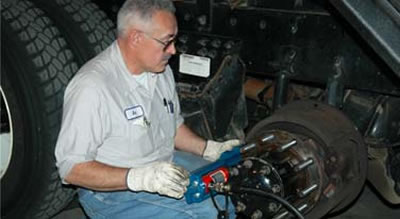
Ken Hentges, a field mechanic at Bemidji, has a knack for tinkering. His latest project had him deep-frying felt washers in lard for use on shafts that drive the salt and sand spinners on snowplows. Photo by Craig Wilkins |
Ken Hentges, a field mechanic at Bemidji, brings a lot of talent to his job, which often includes repairing equipment at truck stations or along roadsides or wherever it has broken down.
He also has a knack for tinkering.
“Some people say I’m a dumpster diver; I just say I’m resourceful,” he said.
Recently, Hentges learned about an idea from District 3 mechanics who were using felt instead of metal washers on shafts that drive the salt and sand spinners on snowplows.
Trouble was, the felt would absorb liquid readily. Most often, he said, the liquid was water containing salt splashed up from snowplowing operations.
Hentges was intrigued by the felt washers, but believed they first needed to be treated to keep water out more effectively.
He tried melted wax, but the wax cracked when temperatures dropped.
So then he cooked up, so to say, another idea—frying them in lard.
He salvaged a deep-fat fryer, then fried the washers in Crisco. Hentges discovered that deep-frying the washers saturates them, improving their ability to repel moisture and keep salt out.
The washers are now being used on snowplows at Bemidji maintenance area.
“So far, they’re working,” Hentges said.
Hentges squeezed the washer project between testing a portable wheel stud remover with Maintenance Operations Research and his regular duties.
When did you join Mn/DOT and what had you been doing previously?
I started working here in Bemidji in 1985, just down the road from Blackduck, my hometown. Before that, I was a diesel mechanic and had my own farm equipment repair business. After high school, I completed a two-year diesel engine repair program at the St. Paul Vocational and Technical College.
How did you develop your mechanical skills and problem-solving abilities?
Mainly by necessity—I grew up on a dairy farm near Blackduck where we had to fix our own equipment and make do with what we had. We were pretty self-reliant. We used bear grease for a lot of things, including as a lubricant when drilling metal.
How are you able to use your skills on the job?
In just about every way I can think of. My main job is fixing equipment and finding ways to better use what we already have, things I have a lot of experience doing.
I also have the opportunity to try out other people’s ideas—and my own. That’s very rewarding.
What’s changed the most since you first started working with Mn/DOT?
Computers and electronics, mainly. We have a lot of them.
What part of your job still creates a sense of excitement or challenge for you?
The challenge I enjoy most is keeping our equipment working so the maintenance folks do their job they way they are supposed to.
When I go out to the field I learn a lot about equipment and how people use it. That also gives me a chance to interact with people and to get a wider view of our operations than I would have by working only in the shop. That perspective helps me anticipate problems and find ways to deal with them when they happen.
I enjoy being resourceful and take pride in a job well-done.
Do you or a co-worker have an interesting job to share with readers? Click here to send us your ideas, and we’ll contact you for more information.
Recent employee profiles:
|
 |
|

|
 |
TABLE of CONTENTS
 |
Peer review: industry panels honor top asphalt paving jobs for 2008 |
By Craig Wilkins
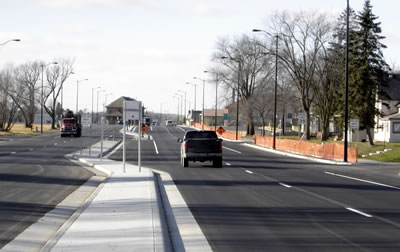
The Minnesota Asphalt Pavement Association recognized the Hwy 10 project in Todd County for use of asphalt in new construction. District 3's Darren Nelson was project engineer on the 2.7-mile project. |
Excellence in the use of asphalt for six projects earned awards for Mn/DOT from the Minnesota Asphalt Pavement Association. A seventh project earned recognition from MAPA for its work zone safety efforts.
The award criteria included ride smoothness, appearance, project complexity and compliance with design standards. The judging panel included paving contractors, asphalt producers, MAPA staff and Mn/DOT representatives.
Awards were presented in the following categories:
New construction
- Hwy 10 in Todd County, 2.7 miles, District 3. Project engineer was Darren Nelson.
- Hwy 212 in Hennepin and Carver counties, 2.5 miles, Metro District. Project engineers were Jon Chiglo, Charles Cadenhead and Mary Lacho.
Reconstruction
- Hwy 24 in Wright County from Annandale to Interstate 94, 12.5 miles, District 3. Project supervisor was Micky Klasen.
Resurfacing (high-volume traffic)
- I-94 in Stearns County between Albany and Melrose, 12.5 miles, District 3. Tim Paul served as project supervisor.
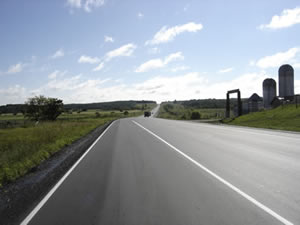
District 3's Hwy 27 in Morrison County received an excellence award from the Minnesota Asphalt Pavement Association in the use of asphalt resurfacing on a low-volume traffic route. |
Resurfacing (low-volume traffic)
- Hwy 27 and Hwy 25, Morrison County, 37.8 miles, District 3. Paul Koenig served as project engineer.
Secondary federal-aid highways
In addition to the five projects, Mn/DOT staff partnered with the cities of Eagan and Inver Grove Heights and a consultant for a 2.6-mile repaving project on Hwy 149 in Dakota County. Project engineers from Mn/DOT were Liz Benjamin and Charles Graf, Metro District.
Work zone safety award
District 3 earned MAPA’s work zone safety award for reconstruction of Hwy 10 in Staples. It was cited for a low number of crashes during the two-year project, the contractor coordinating effectively with schools and emergency responders and local law enforcement agencies’ supporting speed reduction and other safety efforts during flagging operations.
|
 |
|

|
 |
TABLE of CONTENTS
 |
Wetland restoration in Red River Valley earns national FHWA award |
By Craig Wilkins
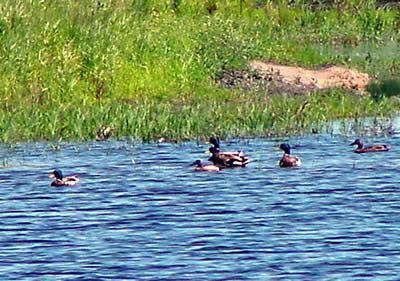
Mallards flock to a wetland pond created by restoring nearly 1,900 acres of land near Winger in the Red River Valley. Photo by Larry Pulchalski |
Restoration of a 1,900-acre tract near Winger in northwestern Minnesota from cropland to a wetland earned honors from the Federal Highway Administration for Mn/DOT and the state’s Board of Water and Soil Resources.
The FHWA cited the restoration as one its nationally recognized exemplary ecosystem initiatives.
"These innovative and forward-thinking initiatives aren't single-issue, project-specific efforts," said FHWA Administrator Mary Peters. "They look at the big picture and they're sure to make a significant difference in future transportation decision-making."
The tract was renamed the Bob Jacobson Restoration Site to honor the late Environmental Services biologist following his death in 2007.
Cheryl Martin, an environmental engineer with the FHWA’s Minnesota Division, said the project reduces runoff and flooding and provides needed habitat for waterfowl and other wildlife in the state’s Red River Valley.
The restored wetland also provides credits to offset the effects of road repair and construction projects on wetlands.
Martin said Mn/DOT and BWSR worked together since the start of the project.
“Mn/DOT staff from the Bemidji District and Environmental Services purchased the land and handled title searches and right-of-way issues,” Martin said, “while BWSR staff managed the project, provided technical assistance on restoring the site and certified wetland replacement credits.
The project, she said, has restored 750 acres of wetlands and 1,150 acres of native upland vegetation. In addition, the work has restored more than 130 individual drain basins.
The restoration also included planting more than 600 acres with native plants, the largest single block of such planting done by a state agency, Martin said.
The Department of Natural Resources provided the seed from a nearby undisturbed prairie. Using seed from that source will ensure that vegetation will parallel plant species on the site before it was drained and filled for farming.
Long-range future effects
The restoration will result in conditions that will lead to a future greenway connection lands owned by the DNR and the U. S. Fish and Wildlife Service downstream.
“Eventually, the Bob Jacobson site will be transferred to the DNR to become a state wildlife management area,” Martin said.
“The site will also link two federal waterfowl production areas to form a contiguous public land site more than 2,600 acres in size,” she said.
|
 |
|
| |
|



